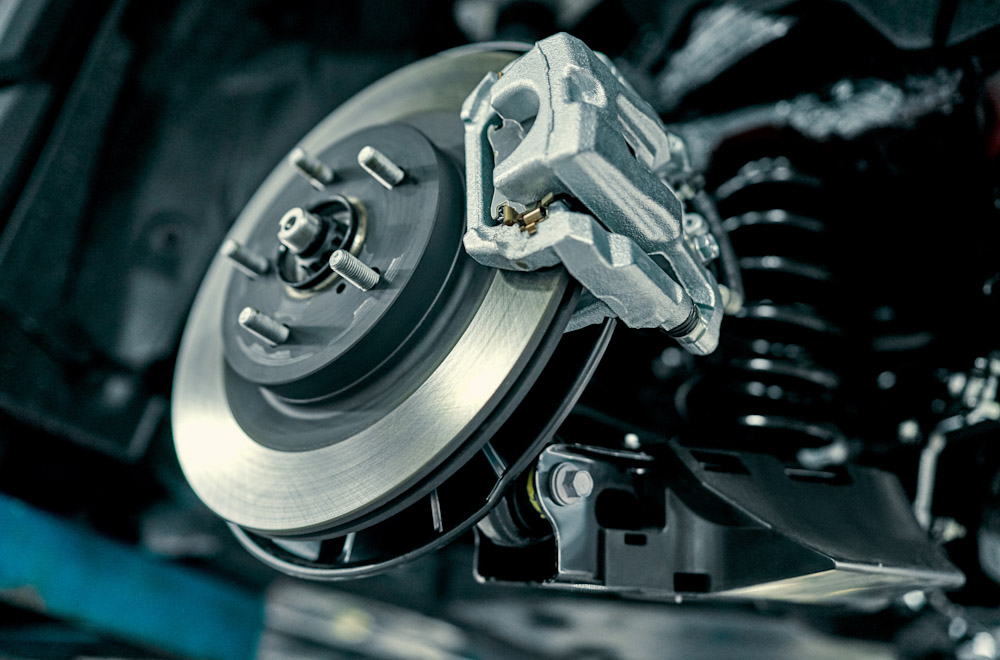
The average car weighs around 2,800 pounds and can, on average, reach speeds of well over 100 miles per hour. With such momentum, it must require a considerable amount of force to bring such an object to a stop— and it does. In our cars, the mechanisms tasked with facilitating such a process are components of the brake system and are fundamental to the operation of the vehicle. Cars use hydraulic brakes which means that fluid is used to transfer pressure from the controlling mechanism to the braking mechanism. Though composed of hundreds of individual parts, the braking system can be broken down into 12 components. They are as follows:
Brake Pedal
Located on the floor to the left of the accelerator, the brake pedal is what initiates the braking process. The average driver generates a peak of 70 pounds of force on the pedal during a moderate stop.
Brake Booster
Simply put, a brake booster is a device that increases the force applied from the brake pedal to the master cylinder. The 70 pounds of force applied to the pedal alone is not enough to bring the wheels to a stop, thus the need for this component.
Brake Master Cylinder
This component is engineered to convert force into hydraulic pressure. The master cylinder essentially forces brake fluid through brake lines to cylinders at each wheel. This ultimately works to bring the vehicle to a stop.
Brake Lines and Hoses
Brake lines are metal tubes that run the length of your car reducing vibration as the fluid makes its way to the brake hose. Brake hoses are short rubber tubes found between the wheels. Both are fundamental to distributing the hydraulic force necessary to brake.
Brake Calipers and Pistons
The duty of calipers is to squeeze the brake pads against the rotors in an effort to slow the spin of the wheel. Pistons are a key component of the caliper that help it carry out its primary functions.
Disc Brake Pads
Found inside the calipers, brake pads are designed to clamp down on the rotor at high speeds creating the friction necessary to stop the vehicle. Brake pads are designed to hold up under considerable heat and friction. Though because of their name one might assume that brake pads are soft, they are actually rock hard, composed of steel backing plates with friction material bound to the surface.
Brake Fluid
As mentioned before, brakes require fluid to transfer pressure from the brake pedal to the wheel. Brake fluid is used in cars, motorcycles, light trucks, and some bicycles to amplify braking force. As it turns out, liquids are not appreciably compressible, which makes them an even better candidate than air for carrying out their specialized functions. Having low brake fluid is a common issue within the braking system that needs immediate attention. If your brakes are particularly stiff noisy, you may be in need of more braking fluid.
If You Have Break Needs, We Can Help
Our brakes are under considerable stress and, therefore, need to be maintained and repaired on occasion. If you are experiencing any of the following problems, there is a good chance that your breaks are going bad.
- Squeaking, grinding, or squealing each time you step on the brake pedal
- Slow braking response
- The pedal can be pushed down much further than usual and provides little resistance to the foot
- Burning smell while driving
- Vibrations
At Master Muffler Kearns, we are experts in brake repair and will make sure everything is working properly. If your brakes are approaching the end of their utility or if you want us to check their wear for free, come pay us a visit today.
Related Posts
As an EV owner, understanding your vehicle's battery is critical. From its capacity to its lifespan, and everything in between, we'll guide you through what you need to know to optimize your EV experience. So buckle up and get ready - we're about to shed some light on the electrifying world of EV batteries. What [...]
If your car is running hot, it can be a sign that something’s not right with your engine. Fortunately, diagnosing the cause of an overheating engine isn't too difficult if you know what to look for and how to address it. Keep reading if you want to learn the most common issues that occur when [...]
Your vehicle's exhaust system serves a critical role in managing the byproducts of the combustion process and ensuring optimal engine performance. The appearance of colored smoke from the exhaust pipe, either when stationary or accelerating, can provide valuable clues to underlying mechanical issues. What is a car exhaust? A car exhaust is a system [...]





